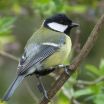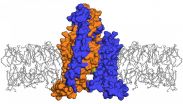NIH-led scientists describe new herpes treatment strategy
2014-12-03
(Press-News.org) Scientists have developed a novel treatment approach for persistent viral infections such as herpes. Using animal models of herpes simplex virus (HSV) infection, researchers show that blocking the activity of a host cell protein called LSD1 reduces HSV infection, shedding (release of viral particles) and recurrence. LSD1, which is essential for HSV's infectious cycle, modifies certain host proteins that control access to DNA. These modifications, known as "epigenetic" changes, help determine how and when genes are used. The collaborative effort, led by scientists at the National Institute of Allergy and Infectious Diseases (NIAID), part of the National Institutes of Health, demonstrates the potential of epigenetic therapy as an antiviral strategy.
After initial infection, HSV enters a latent state in sensory nerve cells, periodically reactivating to produce disease. HSV typically causes recurrent oral or genital lesions and can contribute to the eye disease herpetic keratitis, a leading cause of blindness. Even without symptoms, HSV-infected people can shed and transmit the virus. Current HSV treatments, which target viral proteins, do not effectively control shedding or reactivation of latent virus.
The investigators used an existing drug, tranylcypromine, to block LSD1 activity in three different animal models of HSV infection and disease. The treatment targets a very early stage of the HSV infectious cycle and greatly reduced symptoms of HSV disease, shedding and lesion recurrence. By blocking a cellular rather than viral component, the treatment may minimize the evolution of drug-resistant viruses. The results also indicate that even during latency, HSV's genetic material is subject to epigenetic changes that can be regulated with drugs. Epigenetic therapies are rapidly being developed as cancer treatments, opening the possibility to also test these drugs for antiviral activity.
INFORMATION:
JM Hill et al. Inhibition of LSD1 reduces herpesvirus infection, shedding, and recurrence by promoting epigenetic suppression of viral genomes. Science Translational Medicine DOI: 10.1126/scitranslmed.3010643 (2014).
Authors
Thomas M. Kristie, Ph.D., chief of the Molecular Genetics Section in NIAID's Laboratory of Viral Diseases and the senior author of the paper, is available for comment.
Contact
To schedule interviews, please contact Hillary Hoffman, (301) 402-1663, hillary.hoffman@nih.gov.
This collaborative research effort included scientists from NIAID's Laboratory of Viral Diseases, Louisiana State University Health Sciences Center, University of Alabama at Birmingham, Cincinnati Children's Hospital Medical Center, the Food and Drug Administration and Harvard Medical School. Funding was provided by NIAID and the National Eye Institute, both NIH components, as well as other sources.
NIAID conducts and supports research--at NIH, throughout the United States, and worldwide--to study the causes of infectious and immune-mediated diseases, and to develop better means of preventing, diagnosing and treating these illnesses. News releases, fact sheets and other NIAID-related materials are available on the NIAID Web site at http://www.niaid.nih.gov.
About the National Institutes of Health (NIH)
NIH, the nation's medical research agency, includes 27 Institutes and Centers and is a component of the U.S. Department of Health and Human Services. NIH is the primary federal agency conducting and supporting basic, clinical, and translational medical research, and is investigating the causes, treatments, and cures for both common and rare diseases. For more information about NIH and its programs, visit http://www.nih.gov.
NIH...Turning Discovery Into Health®
ELSE PRESS RELEASES FROM THIS DATE:
2014-12-03
Kansas City, Mo. -- December 3, 2014 -- Results from more than 100 families with children affected by a broad range of neurologic and developmental disorders who underwent genomic testing to end their quest for a diagnosis, were published today in Science Translational Medicine. This is the first study to show that a genome-based diagnostic approach directly impacts patient care of both infants and older children with neurologic disorders. Forty-five percent of families received a diagnosis by exome or genome sequencing, fifty percent of those diagnosed had a change in ...
2014-12-03
PULLMAN, Wash.--Washington State University researchers have found that it is counter-productive to kill wolves to keep them from preying on livestock. Shooting and trapping lead to more dead sheep and cattle the following year, not fewer.
Writing in the journal PLOS ONE, WSU wildlife biologist Rob Wielgus and data analyst Kaylie Peebles say that, for each wolf killed, the odds of more livestock depredations increase significantly.
The trend continues until 25 percent of the wolves in an area are killed. Ranchers and wildlife managers then see a "standing wave of livestock ...
2014-12-03
Koala population distribution may be influenced by eucalyptus leaf toxin and nutrient content, especially in areas with low-quality food options, according to a study published December 3, 2014 in the open-access journal PLOS ONE by Eleanor Stalenberg from The Australian National University and colleagues.
Scientists suspect that access to nutritious food plays a role in herbivore distribution and abundance, but there is still some debate over how variation in plant nutritional qualities may influence population distribution. Koalas predominantly eat eucalyptus leaves ...
2014-12-03
A population of humpback whales that resides in the Arabian Sea may have been isolated for ~70,000 years, according to a study published December 3, 2014 in the open-access journal PLOS ONE by Cristina Pomilla, Ana Rita Amaral, Howard Rosenbaum, and Tim Collins of the Wildlife Conservation Society, the American Museum of Natural History, and their colleagues.
The small, non-migratory population of Arabian Sea humpback whales is currently classified as "Endangered" on the IUCN Red List of Threatened Species. Scientists have limited data on the difficult-to-study population, ...
2014-12-03
Aspects of the culture of research in UK higher education institutions (HEIs) can encourage poor research practices and hinder the production of high quality science, according to scientists who took part in a project exploring the ethical consequences of the culture of research led by the Nuffield Council on Bioethics.
The findings of the project, which included a survey of almost 1000 scientists and others, suggest that scientists are motivated in their work to find out more about the world and benefit society, and that they believe collaboration, multidisciplinarity, ...
2014-12-03
Birds learn new foraging techniques by observing others in their social network, 'copycat' behaviour that can sustain foraging 'traditions' that last years, according to a study of how innovations spread and persist in wild great tits (Parus major).
The study involved experiments with eight local populations of great tits in Wytham Woods, Oxfordshire (UK). In five of the populations two male birds were trained to slide a puzzle box door either to the left or to the right. In three control groups two males were captured but not trained. The birds were then released back ...
2014-12-03
Whether stubbing a toe or stroking a cat, the sensation of touch starts out as a mechanical force that is then transformed into an electrical signal conveying pain or other sensations. Tiny channels in neurons act as translators by helping to formulate that signal to the brain. However, scientists know little about the fine details of how these channels work.
New work at Rockefeller University has revealed that one such channel in humans responds to mechanical force using a never-before-seen mechanism. Researchers led by Roderick MacKinnon, John D. Rockefeller Jr. Professor ...
2014-12-03
A team of biomedical engineers at Washington University in St. Louis, led by Lihong Wang, PhD, the Gene K. Beare Distinguished Professor of Biomedical Engineering, has developed the world's fastest receive-only 2-D camera, a device that can capture events up to 100 billion frames per second.
That's orders of magnitude faster than any current receive-only ultrafast imaging techniques, which are limited by on-chip storage and electronic readout speed to operations of about 10 million frames per second.
Using the Washington University technique, called compressed ultrafast ...
2014-12-03
VIDEO:
NIH-funded scientists developed a promising new drug that may lead to spinal cord injury treatments.
Click here for more information.
Injections of a new drug may partially relieve paralyzing spinal cord injuries, based on indications from a study in rats, which was partly funded by the National Institutes of Health
The results demonstrate how fundamental laboratory research may lead to new therapies.
"We're very excited at the possibility that millions of people ...
2014-12-03
Case Western Reserve scientists have developed a new chemical compound that shows extraordinary promise in restoring function lost to spinal cord injury. The compound, which the researchers dubbed intracellular sigma peptide (ISP), allowed paralyzed muscles to activate in more than 80 percent of the animals tested. The remarkable study, partly funded by the National Institutes of Health, appears in the December 3 edition of the journal Nature.
Case Western Reserve University School of Medicine Professor of Neurosciences Jerry Silver, PhD, the senior author, led an international ...
LAST 30 PRESS RELEASES:
[Press-News.org] NIH-led scientists describe new herpes treatment strategy




